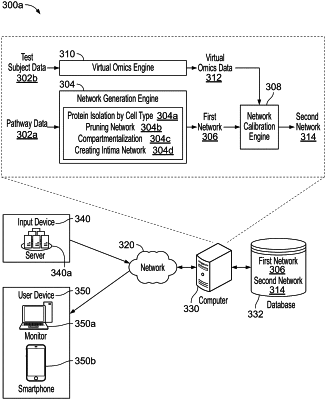| CPC G16H 50/20 (2018.01) [G06N 20/00 (2019.01); G16H 20/10 (2018.01); G16H 50/50 (2018.01); A61B 6/504 (2013.01); A61B 6/5217 (2013.01)] | 24 Claims |

|
17. A clinical decision support system comprising:
a memory configured to store instructions; and
a processor to execute the instructions to perform operations comprising:
inputting, to a neural network, non-invasively obtained data related to a plaque from a patient;
generating virtual 'omics data that include predicted pathway activation or molecule levels, or both, of the patient, by applying the neural network to the non-invasively obtained data from the patient;
updating an in silico systems biology model using the generated virtual 'omics data to generate an in silico patient-specific systems biology model, wherein
(i) the in silico systems biology model comprises a set of networks, wherein each network comprises a plurality of nodes, each node representing a baseline level of a molecule, and a plurality of edges between pairs of nodes, each edge representing a molecule-molecule interaction,
(ii) at least two of the nodes represent molecules whose levels are affected by the atherosclerotic cardiovascular disease, and
(iii) at least one of the set of networks includes a disease-associated pathway activation or molecule level, or both, for each of the nodes in the network;
perturbing the in silico patient-specific systems biology model to simulate a therapeutic effect of a lipid-lowering agent for the patient; and
providing an output indicating a level of improvement in the atherosclerotic cardiovascular disease by the lipid-lowering agent for the patient and a recommendation supporting a clinical decision as to whether the lipid-lowering agent would benefit the patient.
|